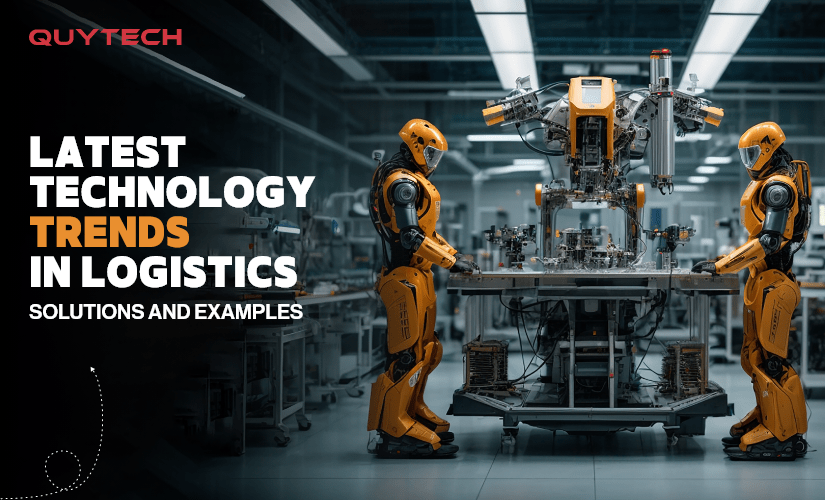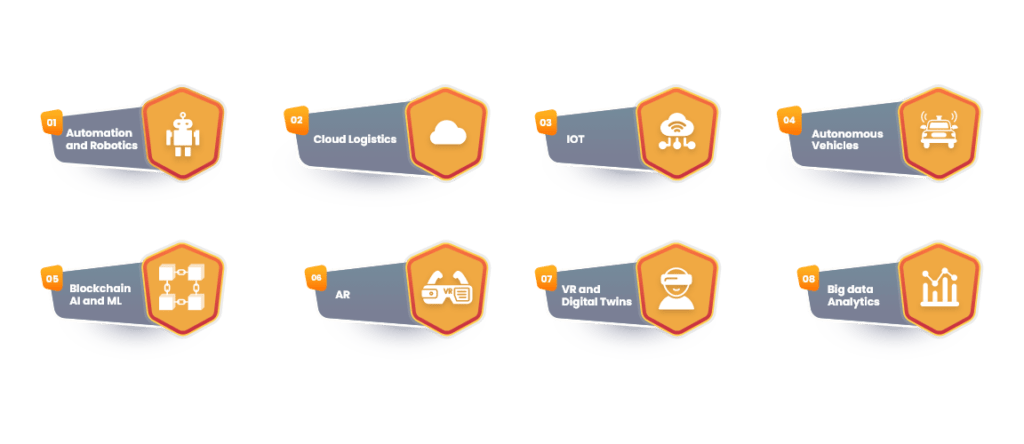“The future belongs to those who understand that doing more with less is compassionate, prosperous, and enduringly desirable” – Paul Hawken
The logistics industry is going through a transformation led by cutting-edge technologies that increase efficiency, transparency, and consumer satisfaction.
As we become more digital and interconnected, these technological innovations are very important in making global supply chains more efficient, responsive, and sustainable. Companies are using technology solutions like AI, Blockchain, IoT, and automation to optimize their supply chain operations.
According to MHI Annual Industry Report 2024, a US-based NFPO, 55% of supply chain leaders are increasing their investment in supply chain related technology innovations while 88% are planning to spend over $1 mn on the same. 42% are planning to spend over $10mn.
According to Statista, the supply chain management software market is expected to hit $20.27 bn by the end of 2024, reflecting exponential growth and the requirement for advanced solutions.
What does “Technology Solutions in Logistics” mean?
Tech solutions in logistics include advanced tools and systems that streamline, automate, and make logistic operations efficient and smooth. These technology solutions include automation, robotics, Blockchain, cloud computing, etc, completely changing the way of transporting, storing, and tracking goods.
By using these technologies, logistic firms can improve operational efficiency, accuracy, and transparency in their supply chain, fulfilling the increasing demand of today’s fast-paced connected world. These solutions make logistics operations more agile, smarter, and sustainable as well.
Technology Trends in Logistics and their Applications
Now we will look at major technology trends in the logistics sector and their applications in brief.
Automation and Robotics
By increasing the speed, accuracy, and efficiency of supply chain processes, automation, and robotics is revolutionizing the logistics industry. Conglomerates like Amazon are the leaders in using these advanced technologies, deploying a vast fleet of robots in their logistics centers to segregate, pick, and pack items. These automated guided vehicles (AGVs) and robotic picking systems, aid human employees to increase productivity and get the job done with accuracy and efficiency.
For example:
Amazon’s Kiva robots can reduce retrieval time and error by carrying shelves of goods to human pickers.
Cloud Logistics
In 2024, cloud logistics will keep on making supply chain management operations more efficient with its scalable and cost-effective solutions. These cloud-based tech solutions will enhance real-time data access, streamline operations, and help in the synchronization of the entire supply chain.
The importance of cloud services in the logistics sector can be understood by the projections of Mordor Intelligence, which shows the Cloud logistics market will touch $16.2bn by 2028.
For example: DHL with the help of Cloud Logistics integrates global operations thereby ensuring responsive service delivery and data flow. DHL can effectively and quickly adapt to market changes, optimize route planning, and improve its inventory management with the help of a Cloud-based system.
Autonomous Vehicles
Autonomous vehicles are transforming the logistics sector in 2024, increasing safety, efficiency, and sustainability. These self-driving delivery fleets can minimize human error and save fuel consumption through AI-driven route optimization and planning.
For example:
UPS has joined hands with TuSimple to deploy self-driving trucks on select routes, reducing transportation costs and delivery time significantly. These self-driving vehicles use advanced sensors and AI to navigate through complicated routes, helping in on-time and reliable delivery. With the help of automation and autonomous tech, logistic players can get seamless, round-the-clock operations meeting the growing demands of the modern supply chain.
IoT
In 2024 IoT is going to revolutionize logistical operations by enabling real-time visibility and firm control on the supply chain operations. IoT like smart sensors and tracker devices are capable of ensuring the optimal condition of goods and their timely delivery by monitoring the condition and their location throughout their journey.
For example: “Schneider Electric” employs IoT sensors to speed up fleet operations and for better energy management. They can track, and optimize routes, supervise vehicle health, and improve overall operational efficiency by integrating IoT with daily operations. This technology helps optimize operational efficiency, supports predictive maintenance, and reduces downtime and costs.
The smart sensors market is valued at USD 61.9 billion in 2024 and is projected to reach USD 136.3 billion by 2029 at a CAGR of 17.1% underscoring its growing significance in logistics.
Blockchain
In 2024, blockchain technology is transforming the logistics industry by enabling secure, transparent, and immutable transaction records. The decentralized ledger system of blockchain increases supply chain efficiency and transparency.
E.g. Maersk in collaboration with IBM utilizes the blockchain platform Tradelens to improve data visibility and reduce manual paperwork. This blockchain-powered platform enables real-time tracking of goods, ensuring that all the concerned parties can access accurate and updated information.
The blockchain supply chain market is projected to grow between 2023 to 2030 at 45.55% CAGR, underscoring the growing importance of blockchain technology in the logistics industry.
AI and ML
In 2024, AI and ML are transforming the logistics sector by predicting demand, optimizing routes, and improving inventory management. AI and ML enable real-time decision-making, reducing costs and increasing efficiency.
E.g. FedEx utilizes AI to streamline package sorting and delivery efficiently. AI algorithms analyze large amounts of data sets to predict demand and increase the right inventory level and on-time deliveries. ML models can also reduce fuel consumption and carbon emissions by optimizing delivery routes. This AI and ML-led approach allows logistics companies like FedEx to meet customer demands and stay ahead of competing players in the market.
AR, VR, and Digital Twins
By improving training, optimizing processes, and enhancing visibility, Augmented Reality (AR), Virtual Reality (VR), and Digital Twins are transforming the logistics sector.
- Through smart glasses, AR technology helps warehouse workers pack and improve visibility.
- VR by offering immersive training simulations, reduces costs and improves employee performance.
- Digital Twins(virtual replicas of physical assets) on the other hand enable real-time monitoring of equipment and their predictive maintenance as well.
DHL employs AR solutions to streamline warehouse operations, while FedEx uses Digital Twins to increase printing efficiency and delivery processes.
Big data Analytics
By leveraging a large amount of data “big data analytics” optimizes logistical operations, providing actionable insights for better decision-making.
E.g. UPS utilizes big data to improve route planning and fleet management. By analyzing real-time data on traffic, weather, and package-related information, UPS’s own ORION(On-Road Integrated Optimization and Navigation) system optimizes route planning reduces fuel usage saves millions of miles annually, and improves delivery times.
According to Infosys, Research shows that 98% of third-party logistics companies and 93% of shippers believe that big data analytics facilitates intelligent decision-making.
How to Integrate Technology Solutions in Logistics Operations?
Implementing any sort of information technology within the logistics system is a gradual and planned process.
First of all, it is important to evaluate current processes and determine where exactly technology can be applied so that it will be effective such as in warehouse management, during transportation, or inventory management.
After that invest in scalable technologies such as cloud computing and IoT for real-time data access and better sync across the supply chain.
Develop technology partnerships to achieve compatibility and implement intensive training of employees to optimize the use of new infrastructures.
Maintain cybersecurity to guard the security of personal and privileged information and trust with stakeholders.
Set KPIs and yearly assess how the business is performing and make appropriate changes if there are shifts in trends in the field.
It takes systematic planning and continuous improvement to introduce and maximize the use of technology in a mechanized supply chain so logistics companies can have a more cost-effective and responsive supply chain.
Conclusion
The logistics sector is currently undergoing the process of complete transformation through the adoption of technological solutions in supply chain management.
Through the use of technologies like AI, IoT, blockchain, and automation, each of which offers various opportunities for efficiency, transparency, and eco-friendliness, logistics firms stand to benefit the most from these innovations.
The incorporation of these advanced technologies therefore not only caters to the requirements of today’s marketplace but also serves as the basis for the intelligent and dynamic future of the logistics industry.

